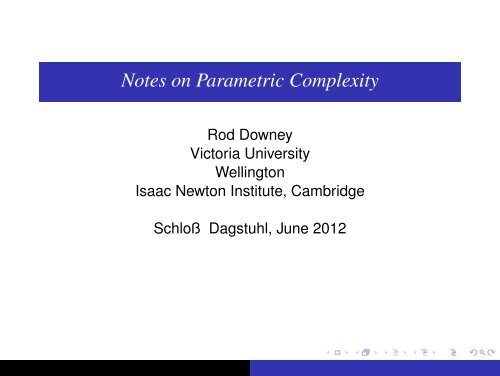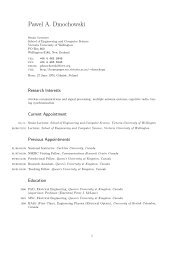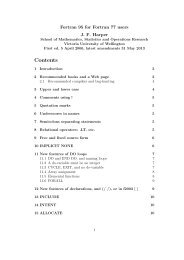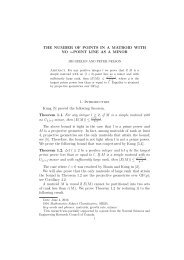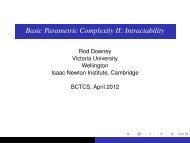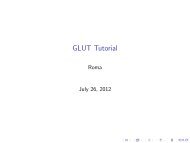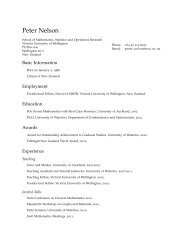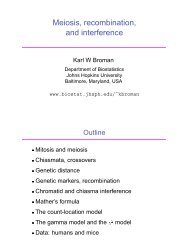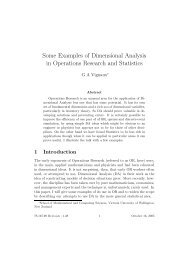Notes on Parameterized Complexity, Dagstuhl, June 2012.
Notes on Parameterized Complexity, Dagstuhl, June 2012.
Notes on Parameterized Complexity, Dagstuhl, June 2012.
Create successful ePaper yourself
Turn your PDF publications into a flip-book with our unique Google optimized e-Paper software.
<str<strong>on</strong>g>Notes</str<strong>on</strong>g> <strong>on</strong> Parametric <strong>Complexity</strong><br />
Rod Downey<br />
Victoria University<br />
Wellingt<strong>on</strong><br />
Isaac Newt<strong>on</strong> Institute, Cambridge<br />
Schloß <strong>Dagstuhl</strong>, <strong>June</strong> 2012
WHEN AND WHERE DID I MEET MIKE?<br />
◮ When : almost certainly December 4th, 1990.<br />
◮ Where : Palmerst<strong>on</strong> North.<br />
◮ At What : ACCMCC (a combinatorics c<strong>on</strong>ference mainly<br />
filled with block designers.)<br />
◮ Palmerst<strong>on</strong> North: John Cleese (of M<strong>on</strong>ty Pyth<strong>on</strong> fame) “If<br />
you ever do want to kill yourself, but lack the courage, I<br />
think a visit to Palmerst<strong>on</strong> North will do the trick.”
WHY WAS I THERE?<br />
◮ Well, there was essentially no research m<strong>on</strong>ey in NZ for<br />
mathematicians/computer scientists.<br />
◮ You needed to work <strong>on</strong> sheep, dairy or kiwifruit.<br />
◮ So if there was any c<strong>on</strong>ference anywhere near we went.<br />
Who knows, you might pick up an unexpected idea. (I still<br />
believe this)<br />
◮ Here is an ideal scientist of 1990 in New Zealand.
WHY WAS MIKE THERE?<br />
◮ The Endless Summer, a famous surf movie had featured<br />
the exotic locati<strong>on</strong> of New Zealand in it.<br />
◮ Mike wanted to surf New Zealand.<br />
◮ Notably no surf in Palmerst<strong>on</strong> North. But he did go to<br />
Castle Point.
MIKE’S TALK<br />
◮ Mike gave a c<strong>on</strong>tributed talk probably about<br />
“N<strong>on</strong>c<strong>on</strong>structive Advances in Polynomial Time”, and I met<br />
him in the foyer after the talk.<br />
◮ I said I have read something like this recently, and it turned<br />
out it was his paper I had read!<br />
◮ We talked and talked over dinner, and he handed me the<br />
Abrahams<strong>on</strong>, Ellis, Fellows and Mata paper and asked me<br />
to try to prove a Ladner type density theorem for it, and<br />
maybe we would find interesting things to do with the<br />
material.<br />
◮ Ladner’s Density: A ≤ p<br />
A < p<br />
T<br />
C
BACKGROUND<br />
◮ Mike Langst<strong>on</strong> has a lot of material <strong>on</strong> the ideas he and<br />
Mike had up to AEFM.<br />
◮ Funded by the Office of Naval Research to use<br />
Roberts<strong>on</strong>-Seymour Theorems to design VLSI!<br />
◮ In retrospect, the Database community, Vardi and others<br />
were looking at complexities, but the AEFM was the first to<br />
suggest asymptotic behaviour of the slices.<br />
◮ The AEFM paper is a difficult read, and is c<strong>on</strong>cerned with<br />
more or less W [P] completeness under logspace by the<br />
slice reducti<strong>on</strong>s, again more or less.
I WAS EXCITED!<br />
◮ At a certain point I recall simplifying the noti<strong>on</strong> of reducti<strong>on</strong><br />
as the AEFM <strong>on</strong>e was hopeless.<br />
◮ Why not study L ⊆ Σ ∗ × Σ ∗ or Σ ∗ × N, and have reducti<strong>on</strong>s<br />
as what we now see as parametric c<strong>on</strong>necti<strong>on</strong>s<br />
(x, k) ↦→ (x ′ , k ′ ).<br />
◮ I was excitedly calling Mike and posting him letters.<br />
◮ He invited me over to Victoria to work with him.<br />
◮ It became clear that there are three definiti<strong>on</strong>s of being<br />
FPT, uniform, str<strong>on</strong>gly uniform and n<strong>on</strong>uniform.<br />
◮ Open Does Ladner’s Theorem hold for uniform and<br />
n<strong>on</strong>uniform?
18TH DECEMBER 1990<br />
◮ I have an e-mail where Mike summarizes the definiti<strong>on</strong>s so<br />
far.<br />
◮ He sets out his ideas about using logical depth as a basis<br />
for hardness classificati<strong>on</strong>, via weft.<br />
◮ That is W [t] is the collecti<strong>on</strong> of problems fp reducible to the<br />
weighted sat problem for cicuits of fixed depth d, large gate<br />
depth t, the small gates allowing for easier inclusi<strong>on</strong>.<br />
◮ He had been thinking about (and now I was) INDEPENDENT<br />
SET, VERTEX COVER, and DOMINATING SET.<br />
◮ When I visited Mike, maybe January 1991, and we spent<br />
maybe two weeks working out the details of Mike’s weft<br />
visi<strong>on</strong>.
◮ For that visit, Mike remembered to meet me off the plane,<br />
something he did not always do....<br />
◮ We had the familiar flip chart, pots of coffee, in his house of<br />
teetering piles of books, and somewhat dubious home<br />
handymanship.<br />
◮ There are still a number of very interesting open questi<strong>on</strong>s<br />
from that e-mail.
MORE OPEN QUESTIONS<br />
◮ If W [t] = W [t + 1] does this cause collapse?<br />
◮ If W [2] =FPT collapse?<br />
◮ Oracle separati<strong>on</strong>s.<br />
◮ The noti<strong>on</strong> of an oracle is interesting here: want<br />
FPT A =FPT if A ∈ FPT. We chose parametrized A and<br />
allow parametric queries so the access mechanism is<br />
essentially ≤ FPT<br />
T .<br />
◮ Oracle separati<strong>on</strong> of the hierarchy.<br />
◮ It might be that the hierarchy collapses to at least W [2]<br />
under randomized reducti<strong>on</strong>s using a variant of Hastad’s<br />
switching lemma
THE MODERN VIEW<br />
◮ Whilst these are interesting, you can easily ask<br />
Do we care?<br />
◮ First the XP optimality program suggests that the<br />
W -hierarchy (much as I love it) could be viewed as an<br />
artifact and M[1] takes a central role.<br />
◮ Sec<strong>on</strong>d, we might ask why the practical FPT algorithms<br />
work so well anyway.<br />
◮ And even things W -hard work effectively, like SAT-solvers.<br />
Gaspers and Szeider have a nice article looking at recent<br />
progress <strong>on</strong> parameterized analysis of SAT-solvers.<br />
◮ I w<strong>on</strong>der if there is a coherent amalgam of PC with<br />
smoothed analysis or generic case complexity.
GENERIC CASE<br />
◮ Look at algorithms which d<strong>on</strong>’t always halt but if they do<br />
they most be correct. (+coarse variati<strong>on</strong>s)<br />
◮ They are correct a lot:<br />
|{σ | |σ| ≤ n ∧ Φ(σ) ↓}|<br />
lim<br />
n→∞ |Σn → 1.<br />
|<br />
◮ This should happen exp<strong>on</strong>entially fast and and the running<br />
time of Φ should be fast. (eg group theory)<br />
◮ It is more easily applied than things using distributi<strong>on</strong>s and<br />
the like. Borel density is not a measure.
BACK TO THE EARLY YEARS I<br />
◮ Mike took me to a place called Sombrio Beach.<br />
◮ In those days, <strong>on</strong>ly ex-hippies in shacks lived in sombrio,<br />
now they have been “moved <strong>on</strong>” and it is a crazy busy part<br />
of the west coast trail.<br />
◮ We always ate at Shakies; Oyster Burgers.<br />
◮ In a later trip, I remember Niel Koblitz all in black looking<br />
very out of place (and that’s where FPT=kernelizable came<br />
from).<br />
◮ Shakies is where Mike tried to kill <strong>on</strong>e of his visitors with an<br />
oyster.
BACK TO THE EARLY YEARS II<br />
◮ We had a first draft “A Completeness Theory for Fixed<br />
Parameter Problems”<br />
◮ New definiti<strong>on</strong>s, weft ideas, some hardness proofs,<br />
◮ k-PERFECT CODE, k-NOT ALL EQUAL SAT, k-CNF SAT,<br />
k-DOMINATING SET, k-INDEPENDENT DOMINATING SET,<br />
mostly correct.<br />
◮ FTP examples like FEEDBACK VERTEX SET, PLANAR FACE<br />
COVER NUMBER, MIN CUT LINEAR ARRANGEMENT,<br />
GRAPH GENUS<br />
◮ Mike gave the first talk <strong>on</strong> this around this time in<br />
Manitoba. Plus we submitted probably the best paper ever<br />
in C<strong>on</strong>gressus Numerantium.<br />
◮ Submitted to FOCS.
THE GREAT KIWI ROADTRIP<br />
map new zealand north island - Google Maps https://maps.google.co.uk/maps?hl=en&client=firefox-a&q=m...<br />
Address Waikato<br />
New Zealand
◮ After Blacks Reef, I drove the tricky bit of road from Mahia<br />
to Napier.<br />
◮ Of course Mike slept, having run out of eggs to eat, <strong>on</strong>ly<br />
waking to complain about my choice of music (Lou Reed).<br />
◮ We arrived late in Napier and stopped for a drink at the first<br />
pub <strong>on</strong> the road, not noticing that there were <strong>on</strong>ly trucks<br />
outside.<br />
◮ The characters in the bar:
MATHS ON THE TRIP<br />
◮ We figured out the planar gadget.<br />
◮ We thought that the W [1, t] classes would stratify.<br />
◮ Recall W [1, t] is weighted t-CNF<br />
◮ Got the reducti<strong>on</strong> for RED/BLUE NONBLOCKER and hence<br />
the completeness for CLIQUE and INDEPENDENT SET.<br />
◮ Recently recycled in the Turing lower bound completeness<br />
paper of Hermelin, Kratsch, Soltys, Wahlström, and Wu,<br />
which is a great program of miniature miniatures.<br />
◮ Natural basic hardness class: W [1].
◮ Notice that circuits were the original basis.<br />
◮ Only later with Liming and Jianer did we get the<br />
completeness of SHORT NTM ACCEPTANCE.<br />
◮ Open What about k log n-NTM satisfiability and M[1]?<br />
◮ Then lots of c<strong>on</strong>crete reducti<strong>on</strong>s, rejecti<strong>on</strong> from FOCS and<br />
(later) acceptance by CCC (then called Structures), 1992.<br />
◮ The basic papers I and II.<br />
◮ I spoke <strong>on</strong> this at Schloß <strong>Dagstuhl</strong> 9.00 am <strong>on</strong> M<strong>on</strong>day the<br />
3rd of February 1992 having come in <strong>on</strong> a plane from NZ<br />
the night before.
WHAT DOES THE MATERIAL FROM THEN SHOW?<br />
◮ I think we wr<strong>on</strong>gly focused too much <strong>on</strong><br />
Roberts<strong>on</strong>-Seymour and hardness. The big selling point is<br />
tractability, and especially industrial strength.<br />
◮ There were some amazing successes: notably<br />
k-PROCESSOR SCHEDULING is a prominent problem in the<br />
back of Garey and Johns<strong>on</strong>. Hans and Mike showed it is<br />
W [2]-hard. This means that, assuming FPT = W [2], there<br />
should be no feasible algorithm for large k. Later<br />
Alenknovich and Razborov.<br />
◮ 25th February, 1991, Mike said “As for practical, I d<strong>on</strong>’t<br />
know. It’s a bad news theory. Apart from completeness<br />
there are some fun positive results...”<br />
◮ The big change was Mr Feasible, <strong>Parameterized</strong><br />
computati<strong>on</strong>al feasibility, and then its heirs particularly<br />
those with Ulrike.<br />
◮ “the extent to which FPT is really useful us unclear.”
MAYBE ON ULRIKE’S VISIT
THE MODERN INCARNATION<br />
◮ This is the exciting thing of the last decade.<br />
◮ The development of tools to match (up to O) upper and<br />
lower bounds, beginning with Cai and Juedes.<br />
◮ M[1] =FPT or ETH implying tight membership of XP.<br />
◮ Perhaps not known by every<strong>on</strong>e:<br />
sd = inf{ɛ | ∃O ∗ (2 ɛn ) algorithm for n variable d −CNFSAT}.<br />
◮ Clearly sd ≤ sd+1. We can define s∞ = limd→∞ sd.<br />
◮ Impagliazzo and Paturi noted that ETH means that<br />
infinitely many sd < sd+1.<br />
◮ SETH is that s∞ = 1.<br />
◮ Can be used for str<strong>on</strong>g lower bounds, see Cygan, Dell,<br />
Lokshtanov, Marx, Nederlof, Okamoto, Paturi, Saurabh,<br />
Wahlström applied to SET SPLITTING and HITTING SET.
FOR EXAMPLE<br />
THEOREM (LOKSHTANOV, MARX AND SAURABH)<br />
If INDEPENDENT SET can be solved in time O ∗ ((2 − ɛ) tw(G)) )<br />
for some ɛ > 0, then for some δ > 0 we can solve SAT in time<br />
O ∗ ((2 − δ) n ).
AW AND PSPACE<br />
◮ Mike in an e-mail of February 27, 1991. Mike says he<br />
noticed this “weird thing”; which was that a certain problem<br />
whose unparameterized versi<strong>on</strong> was in ΣP 2 did not seem to<br />
fit the model we had.<br />
◮ “Maybe the whole hierarchy is some kind of analog of the<br />
polynomial time hierarchy...” “Or maybe there is some kind<br />
of weird combinatorial reducti<strong>on</strong> placing this above the<br />
current hierarchy.”<br />
◮ Developed into the AW-hierarchy.<br />
◮ In case you forgot... ∃ weightk 1x1∀ weightk 2x2 . . . .<br />
◮ Home of k move games.
◮ COMPACT NTM (COMPUTATION)<br />
Instance:A n<strong>on</strong>deterministic Turing machine M and a word<br />
x.<br />
Parameter: A positive integer k.<br />
Questi<strong>on</strong>:Is there an accepting computati<strong>on</strong> of M <strong>on</strong> input<br />
x that visits at most k work tape squares?<br />
◮ Cai, Chen Downey and Fellows COMPACT NTM<br />
(COMPUTATION) is AW [SAT ] -hard.<br />
◮ Open; Is it AW [P] complete/hard? Falsely claimed in the<br />
DF book.<br />
◮ Open What is the correct treatment of parameterized<br />
space?<br />
◮ Open Is there any analog of QBFSAT aligning to space?<br />
◮ Open What is the parameterized versi<strong>on</strong> of interacti<strong>on</strong>?
OTHER 90’S THINGS<br />
◮ Downey-Fellows-Regan development of ⊕P,<br />
parameterized BW[1] etc.<br />
◮ Proof that W [t] reduces to unique W [t] under randomized<br />
parameterized reducti<strong>on</strong>s.<br />
◮ Later (not 90’s) Müller proved the same for e.g. unique<br />
independent set etc.<br />
◮ Open <strong>Parameterized</strong> Toda’s Theorem?<br />
◮ Possibility AW [P]k reduces to #W [P] under randomized<br />
FPT reducti<strong>on</strong>s. Possibly the A-hierarchy of Flum and<br />
Grohe.<br />
◮ Open paramerized PCP. Perhaps this can be used for<br />
parameterized approximati<strong>on</strong>.
◮ Also Cesati easier membership, his Turing way.<br />
◮ The W ∗ -hierarchy. In case you forgot: the depth of W ∗ [t] is<br />
a functi<strong>on</strong> of the parameter k instead of a c<strong>on</strong>stant as per<br />
W [t].<br />
◮ Mike proved with Taylor that W ∗ [1] = W [1] and<br />
W ∗ [2] = W [2], to solve a questi<strong>on</strong> of Yannakakis and<br />
Papadimitriou.<br />
◮ Open Is W ∗ [t] = W [t] for t ≥ 3?
COMPLEXITY POST-DF<br />
◮ Entry of Martin Grohe, Jorg Flum, Venkatesh Raman, Rolf<br />
Nidermeier and others.<br />
◮ Now the next generati<strong>on</strong>.<br />
◮ Flum-Grohe approach basing the whole thing <strong>on</strong> model<br />
checking. Make the logical depth more apparent. The<br />
A-hierarchy and E-hierarchies (with Weyer)<br />
◮ <strong>Parameterized</strong> approximati<strong>on</strong> Three groups of authors, but<br />
an old questi<strong>on</strong> of Mike: is there an FPT algo for<br />
(k, 2k)-DOMINATING SET (Open).<br />
◮ Complete inapproximability.<br />
◮ Flum-Grohe-Grüber reducti<strong>on</strong>s. Marx the best results.<br />
◮ Open no general theory.<br />
◮ <strong>Complexity</strong> and completeness for kernels.<br />
◮ Open what about iterative compressi<strong>on</strong>? What about<br />
incremental computati<strong>on</strong>? Open What about bounded<br />
search trees, though Daniel has a completeness progarm<br />
here.
REFLECTIONS<br />
◮ Those early years were incredibly fun and productive. Mike<br />
and I have 1 book, 2 edited volumes and 34 papers<br />
together now, kind of like a marriage.<br />
◮ The decade after the 90’s has seen the visi<strong>on</strong> of the<br />
extended discourse with a problem being realized with<br />
some amazing positive techniques and negative toolkit<br />
becoming very polished.<br />
◮ Mike has been at the heart of much of this, as have many<br />
of the “old troupers” (who I w<strong>on</strong>’t name, as maybe some<br />
d<strong>on</strong>’t think they are so old).<br />
◮ So I finish with<br />
“C<strong>on</strong>gratulati<strong>on</strong>s Mike!!


